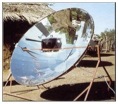Project Surya and Cleaner Cooking
 A woman cooks using traditional biomass-fueled fire.
A woman cooks using traditional biomass-fueled fire.
For the purposes of evaluating the impact and plausibility of cleaner-cooking technologies in the study area, we will replace the conventional cooking practices (burning of wood, cow dung and crop residues) with solar stoves (when sunlight is available) and other energy efficient back-up cookers during evenings, nights, cloudy and rainy days.
Various technological options proposed for substituting firewood burning with green, smokeless renewable technologies are already available and a few are highlighted below.
Parabolic domestic cookers
 Parabolic solar cooker.
Parabolic solar cooker.
These cookers are parabolic dish cookers of about 1.4 m diameter popularly referred to as SK14 and cost about $100. They are advertised as able to cook rice for a family of up to ten people in about 30 minutes. Manual tracking of the sun is required every 20 minutes. In most of the cases food is cooked in this time. With respect to safety issues, glaring can distract the operator if he is standing very close to the cooker. Use of dark goggles is recommended. Even though no cases of burns have been reported, use of gloves is recommended. Normally goggles and gloves are standard accessories supplied with the solar cookers. The cooker is on four caster wheels and can be transported short distances easily, especially for moving inside the house at night in theft-prone areas.
Parabolic community dish cookers
These new dish cookers are 2.3 m in diameter, and cost about $500. They are made by PRINCE group in India, among others. These dish cookers are capable of cooking meals for around 40 students in one hour and are recommended for use in schools where mid-day meal is served.
Biogas plants and burners
To supplement operation of solar cookers, biogas plants are  Biogas plants convert organic waste into energy.recommended. Biogas will be required for cooking during evenings and nights and on cloudy days, as well as for cooking operations like frying, bread making, etc. which are difficult on solar cookers. One unit can serve four families comfortably and costs about $1000. Family-size (2-4 m3 gas per day) biogas plants have been disseminated and popularized in India, China and many other countries (Bhat et al., 2001). Over 3 million biogas plants have been built in India alone. 20 local artisans and fabricators can be trained for constructing the biogas plants and fabricating floating drums. In the rural area of Sirsi, in Uttar Kannada district (south west of India), 3718 family-size biogas plants were built between 1985 and 1999. Operating at a 100% success rate as of 200110, these biogas plants were built by local rural contractors and artisans.
Biogas plants convert organic waste into energy.recommended. Biogas will be required for cooking during evenings and nights and on cloudy days, as well as for cooking operations like frying, bread making, etc. which are difficult on solar cookers. One unit can serve four families comfortably and costs about $1000. Family-size (2-4 m3 gas per day) biogas plants have been disseminated and popularized in India, China and many other countries (Bhat et al., 2001). Over 3 million biogas plants have been built in India alone. 20 local artisans and fabricators can be trained for constructing the biogas plants and fabricating floating drums. In the rural area of Sirsi, in Uttar Kannada district (south west of India), 3718 family-size biogas plants were built between 1985 and 1999. Operating at a 100% success rate as of 200110, these biogas plants were built by local rural contractors and artisans.
We are not restricted to the above cookers and are open to other types of cookers and burners that reduce emissions of soot, smoke and greenhouse gases. We will consult with the Ministry of New and Renewable Energy (http://mnes.nic.in/) to explore other alternatives as well as subsidies for the solar cookers, biogas plants and other alternatives.
Next: Mobile Phone Technology
